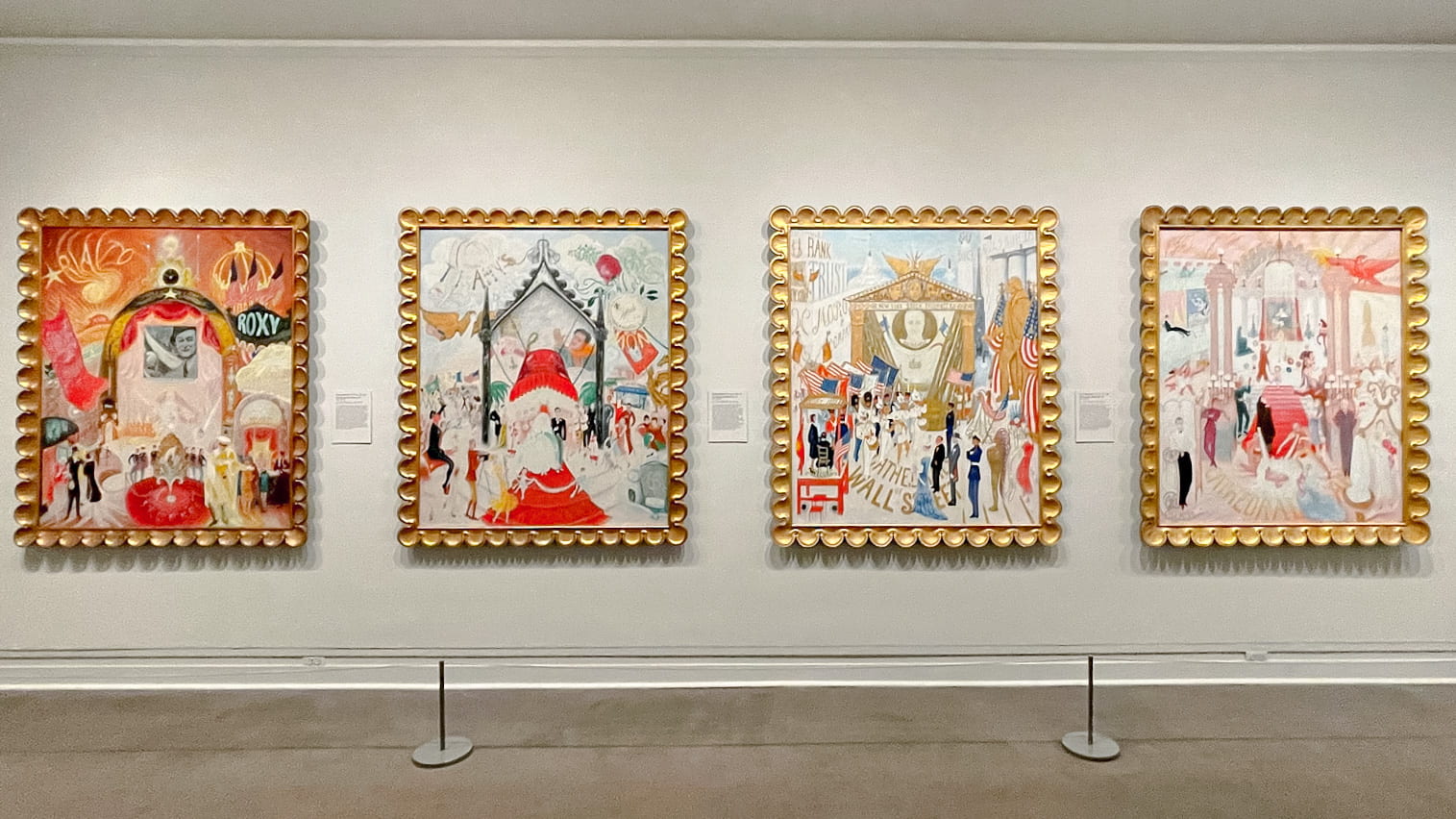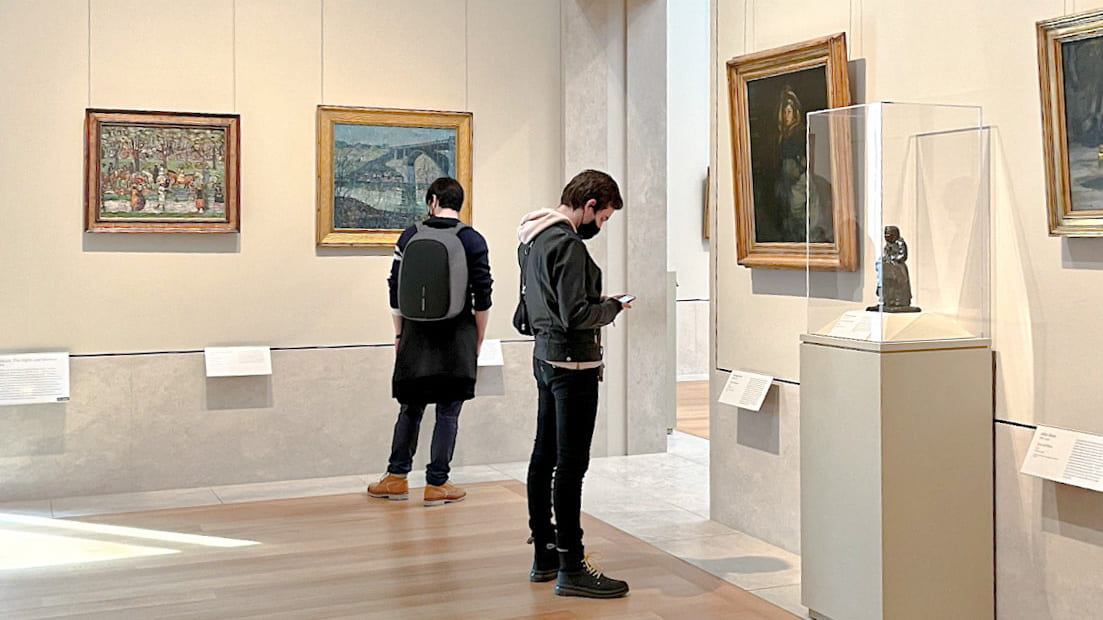In the latest blog post for the Cornell AAP NYC’s art history of the city course, Josue Herrera (B.F.A. ’23) recounts the class’ visit to the Metropolitan Museum of Art. The class visited the modern American gallery housing works by the Ashcan School, a group of artists working in New York City during the late 19th-early 20th century, and discussed the dynamic between European artistic traditions, avant-gardism, and American artists based in New York.

The Metropolitan Museum of Art, an encyclopedic museum, displays over 5,000 years of art from all over the world. Walking towards one of the most featured institutions along “Museum Mile,” its stately appearance was undeniable, much like the Art Institute of Chicago in my hometown. Having grown up in Chicago, I would visit the museum often, and I noticed a strong similarity instantly. The Met’s European architectural influence, the Beaux-Arts style, was clear as soon as we saw its façade. We walked through the grand columns flanking the institution’s entrance, which made it feel like a palace. Functionally, compared to the Art Institute of Chicago, the Met’s layout offers a complex and dynamic experience. Inside, we were greeted with a sense of wealth, with its grand staircases in the main lobby, high white ceilings, and polished finish. It gives New Yorkers and visitors a chance to experience luxury and wealth they might not have at home. With such a variety of works at every bend, it seems the Met’s labyrinth-like layout was intentionally made to draw visitors back into itself. This is no one-day-fits-all museum, so leaving gives visitors a good excuse for return, given how much is on display.
Our outing helped me to understand the museum’s history and its relationship to its location in the United States, and New York City in particular. We discussed the museum’s initial lack of interest in modern American art and the contemporary artists who were working in its immediate proximity. Since its founding in 1870, the Met was not interested in displaying or collecting art by contemporary American artists, instead favoring work made by European artists. We went to gallery 772, in the American Wing, which held works made by a group of artists working in the early 20th century, known as the Ashcan School. Compared to the many large, grand halls, this incredibly small gallery, displaying few paintings and sculptures by students of Robert Henri, seemed a dramatic contrast.
In the late 19th and early 20th centuries, it was common practice for American artists, who could afford it, to train in France. Many American artists did not have funding to obtain European master training. It seemed as if the work of American artists without European training didn’t have the essence of what the Met valued. Another reason why the museum declined works by modern American artists was because at that time the Met wanted to be viewed as a worldly establishment where one could see antiquities from different places around the world, all under one roof.
We learned about Gertrude Vanderbilt Whitney, an American artist who was able to travel to Europe to study sculpture but came back with a renewed attention to fostering a community of American artists working primarily in New York City. Gertrude Vanderbilt Whitney came from great wealth—the daughter of Cornelius Vanderbilt II, and granddaughter of “Commodore” Cornelius Vanderbilt, one of the titans of the American Railroad industry. He was one of the richest Americans in history. After Whitney’s stay in France apprenticing with master sculptor Auguste Rodin, who himself was once rejected from art school, she went back to America where she created a community of artists and friends. She supported them and displayed their work in her studio in Greenwich Village, NY. Whitney bought and developed a collection of artworks by some of the most famous American artists, including Edward Hopper. After gathering a body of works, she sought to donate them to the Met. In turn, they declined her offer, since her collection comprised only contemporary American art. Whitney decided to create her own space to display work from artists in her world, since there were limited, if any, options for their representation. If it was not for Whitney buying works and offering public access to their display in her own museum, we would not know many of the American artists popularly known today. Whitney developed artists’ careers by acknowledging and taking a fresh approach from European tradition, bringing focus back to innovative artists at home.

One of our on-site assignments was an ekphrasis exercise. This involved picking a work and reacting to it and its environment with descriptive and illustrative language. I chose Robert Henri’s Dutch Girl in White painted in 1907. This portrait of a young beautiful lady in white is depicted in a holy light. At first glance, she resembles an angel with a halo overhead, but in fact, she is just wearing a hat. She looks to the side, revealing blushed cheeks. The brushstrokes on the Dutch girl’s dress appear to be quick and gestural, whereas her face is more in focus and painted more tightly, in detail. Black frames the shining girl, who appears in a void. The viewer may interpret their own ideas about how the background relates to the foreground. To me, “a light in the darkness” came to my mind when seeing the image whole.

Across from Henri’s Dutch Girl is a painting by George Luks titled The Old Duchess with a contrasting subject: an old, ragged, and dirty woman, also Dutch. Rather than having bright colored clothes, the old Dutch lady seems to have layers of dark sooty garments, who seems to be scouring around the streets, potentially without a home. She seems to look directly at the viewers with an alarmed glare. It can be also inferred that we are catching her in some sort of sudden act, like coming out of a dark alley. Both paintings represent the dynamics of American and European relations in their moment: an exchange of populations with increased immigration to the United States and the integration of revered yet rival artistic styles.
